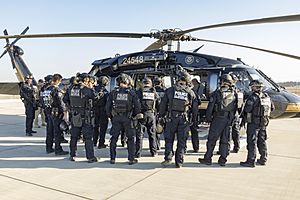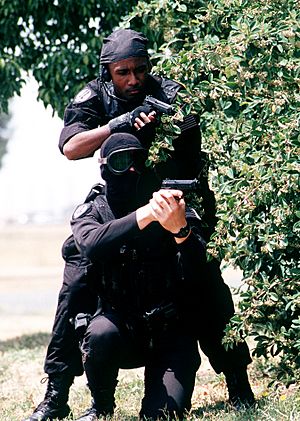SWAT facts for kids
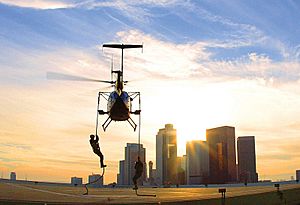
A SWAT team stands for Special Weapons and Tactics. It is a special police unit in the United States. Other countries also use this term.
SWAT teams are trained and equipped for "high-risk situations." These are situations that regular police officers might not be ready for. Examples include shootouts, standoffs, raids, hostage-takings, and terrorism. SWAT units use special weapons and gear. This includes automatic firearms, powerful sniper rifles, stun grenades, body armor, and armored vehicles. They also learn special skills like close-quarters combat (fighting in small spaces) and crisis negotiation (talking to people in tough situations).
The first SWAT teams started in the 1960s. They helped control riots and deal with dangerous criminals. Their use grew in the 1980s and 1990s after events like the North Hollywood shootout and the Columbine High School massacre. After the September 11 attacks in the 2000s, SWAT teams also focused more on counterterrorism. By 2015, SWAT teams were called out almost 80,000 times a year. They often helped serve search warrants for serious crimes.
Contents
What is a SWAT Team?
The National Tactical Officers Association in the United States defines SWAT as:
A special law enforcement team. Its members are chosen, trained, and equipped to handle serious situations. These situations threaten public safety. They are too difficult for regular police or investigators to handle alone.
How SWAT Teams Started
Early Days: The 1960s
The term "SWAT" was first used in 1964. The Philadelphia Police Department created a 100-person unit called "Special Weapons and Tactics." This unit was formed because of many bank robberies. Their goal was to quickly stop bank robberies using many trained officers with strong weapons. This method worked well for other dangerous situations too.
The Los Angeles Police Department (LAPD) started its own SWAT team in 1967. LAPD Inspector Daryl Gates wanted to call it "Special Weapons Attack Team." But his boss, Edward M. Davis, approved "Special Weapons and Tactics" instead.
The LAPD promoted SWAT teams for several reasons. After the Watts riots in Los Angeles in 1965, the LAPD needed new ways to handle large-scale unrest. They also worried about lone gunmen who might be better armed than regular police.
After the LAPD created its SWAT team, many other police groups in the United States started their own special units. Daryl Gates, who supported the idea, said he didn't invent SWAT tactics. But he helped his officers develop them.
One officer, John Nelson, had the idea for a specially trained LAPD unit. It would respond to shootings and reduce police injuries. Inspector Gates approved this. The first LAPD SWAT unit had 15 teams of four officers, totaling 60 people. These officers received special training every month. They also protected police buildings during civil unrest.
The first major use of LAPD SWAT was on December 9, 1969. Police tried to arrest members of the Black Panthers. This led to a four-hour standoff. Over 5,000 shots were fired. Four Panthers and four officers were injured. The Panthers eventually gave up.
By 1974, SWAT was widely accepted as a police resource in Los Angeles.
The 1974 Symbionese Liberation Army Shootout
On May 17, 1974, a group of heavily armed people called the Symbionese Liberation Army (SLA) hid in a house in Los Angeles. Millions watched on TV and radio as SWAT teams fought them for several hours. No police were hurt. Six SLA members died when the house caught fire.
After this shootout, SWAT teams changed. They were organized into six 10-person teams. Each team had two five-person units. These units used sniper rifles, semi-automatic rifles, and shotguns. SWAT officers also carried their service revolvers. They had first aid kits, gloves, and military gas masks. This event led to SWAT teams getting body armor and more powerful weapons.
An LAPD report after the SLA shootout explained why SWAT was needed. It mentioned riots, snipers, political assassinations, and the threat of urban groups. The report said, "The purpose of SWAT is to provide protection, support, security, firepower, and rescue to police operations in high personal risk situations where specialized tactics are necessary to minimize casualties."
More SWAT Teams: The 1980s and 1990s
In 1981, the U.S. Congress passed a law. It allowed police to use military resources to fight crime. This led to more SWAT teams being formed. By 1996, SWAT teams were conducting 30,000 raids each year. Many of these were for serious crimes.
During the 1990s, the U.S. Department of Defense gave military equipment to police departments. This helped increase the number of SWAT teams and their operations. Studies showed that the use of these special police units grew tenfold between the early 1980s and late 1990s.
The Columbine Shooting
The Columbine High School massacre in Colorado on April 20, 1999, greatly changed SWAT tactics. When the shooting happened, officers waited outside as they were trained to do. By the time they entered, many people had been killed. Police were criticized for not going in sooner.
This event led to a new approach. Now, regular police officers are trained and armed to respond quickly to "active shooter" situations. They no longer just wait for SWAT. They are taught to assess the situation fast and act to save lives.
After 9/11: Focus on Terrorism
After the September 11 attacks, SWAT policing expanded even more. This was part of the "War on Terror." Some people believe this led to police forces becoming more like the military. Others argue it was a natural step for police to become more professional.
By 2005, SWAT teams were deployed 50,000 times a year in the United States. Most of these were to serve arrest warrants. Officers say SWAT teams are used to keep everyone safe. For example, in 2006, very few police officers were killed during arrests for serious crimes. This might be because of the military-style equipment and tactics used.
However, some critics argue that more SWAT raids have led to more dangerous situations for innocent people. They worry about the increasing use of SWAT teams for everyday police tasks.
How SWAT Teams Work
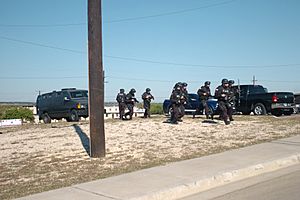
SWAT officers are highly trained. But they can't just wait for an emergency. In many police departments, SWAT officers do regular police duties. They are called for SWAT missions using pagers, phones, or radios. Even in big cities, SWAT personnel might work in crime prevention roles. These are more dangerous than regular patrol, but they don't carry their special armor and weapons all the time.
To respond faster, SWAT equipment is often kept in special lockers in police cars. This means officers don't have to go back to a station to get their gear.
For example, in 2003, LAPD SWAT units were called out 255 times. The NYPD's Emergency Service Unit is one of the few special police units that works 24 hours a day. This unit also does other jobs like search and rescue.
The need to call officers from different places and get them ready can cause delays. The problems with delayed police response at Columbine led to changes. Now, regular officers are trained to quickly respond to active shooters. They don't just set up a perimeter and wait for SWAT.
SWAT Equipment
SWAT teams use special equipment for different situations. This includes fighting in small spaces in cities. The exact gear varies, but some things are common. Much of their equipment is similar to what the military uses.
Clothing
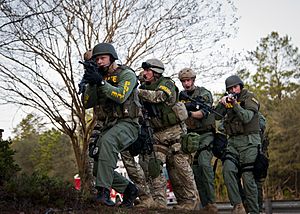
SWAT officers wear uniforms like military personnel. These uniforms are usually dark blue, black, grey, tan, or olive green. Some SWAT units also use military camouflage patterns.
Early SWAT teams used different headgear, like military helmets or even soft caps. Modern SWAT units use helmets similar to those worn by the U.S. military. They might also use riot helmets. Balaclavas (face masks) and goggles are often used to protect faces and keep team members' identities private. Ballistic vests are standard. These vests often say "POLICE," "SHERIFF," or "SWAT" for easy identification.
Weapons and Tools
SWAT units have special weapons not used by regular police. These include assault rifles, submachine guns, riot shotguns, and sniper rifles. They also use riot control agents, smoke grenades, and stun grenades. Even though they have powerful weapons, SWAT teams are still police. They are trained to make arrests. So, they also use less-lethal weapons. These include tasers, pepper spray, and rubber bullets to stop suspects without causing serious harm.
Many SWAT units also have special tools. These include ballistic shields (bulletproof shields), tools for breaking down doors, battering rams, armored vehicles, thermal and night-vision devices, and motion detectors. Police dogs may also work with SWAT teams.
Vehicles
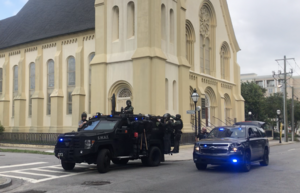
SWAT units often use special armored vehicles. These are called "armored rescue vehicles" (ARV). They help move officers and rescue people safely during dangerous operations. Common armored SWAT vehicles include the Lenco BearCat and the Lenco BEAR. Some police departments get old military vehicles from the government. Sometimes, SWAT teams use unmarked police cars to respond faster or avoid being noticed.
Police aircraft, like helicopters, are used for looking from above or for officers to drop down using ropes.
The use of armored vehicles by SWAT teams is sometimes debated. Some people say these vehicles can make situations more tense. Even small police departments sometimes get armored vehicles, even if they don't have many serious incidents.
SWAT in China
In China, police departments use the term "SWAT" (called Tèjǐng or "Special Police"). These are police tactical units. Besides fighting terrorism and responding to active shooters, Chinese SWAT teams also help with riot control and disaster relief. They are sometimes called "Patrol SWAT."
Chinese SWAT vehicles are usually black. Many SWAT teams in China also do regular patrol duties when they are not on special missions. In some smaller police departments, SWAT units also work with police dogs.
Chinese SWAT often trains in fast-roping (sliding down ropes), sniping, and special driving moves.
Special SWAT Teams
Prison SWAT
Some prisons in China have "Prison SWAT" teams. They respond to sudden events in prisons, like riots. They also provide security when prisoners go to the hospital and search for illegal items. In some areas, Prison SWAT also helps with firefighting inside the prison.
Some prisons with female prisoners have all-female SWAT teams. These teams handle issues in the female prison areas.
Important Events Involving SWAT
United States
- 1973 Brooklyn hostage crisis
- North Hollywood shootout
- Hurricane Katrina disaster relief
- Virginia Tech shooting
- Sandy Hook Elementary School shooting
- 2016 shooting of Dallas police officers
- Pulse nightclub shooting
- 2017 Las Vegas shooting
- Uvalde school shooting
China
- Arrest of Fa Ziying (Nanchang SWAT)
- Disaster relief after the 2008 Sichuan earthquake (Shenzhen SWAT)
- Security during the 2008 Beijing Olympics (Beijing SWAT)
- 2011 Hotan attack (Hotan SWAT)
- 2014 Kunming attack (Kunming SWAT)
See also
 In Spanish: SWAT para niños
In Spanish: SWAT para niños
- List of police tactical units
- Emergency Service Unit
- Special reaction team (U.S. military police)
- SWAT World Challenge
- Militarization of police
- Riot police


